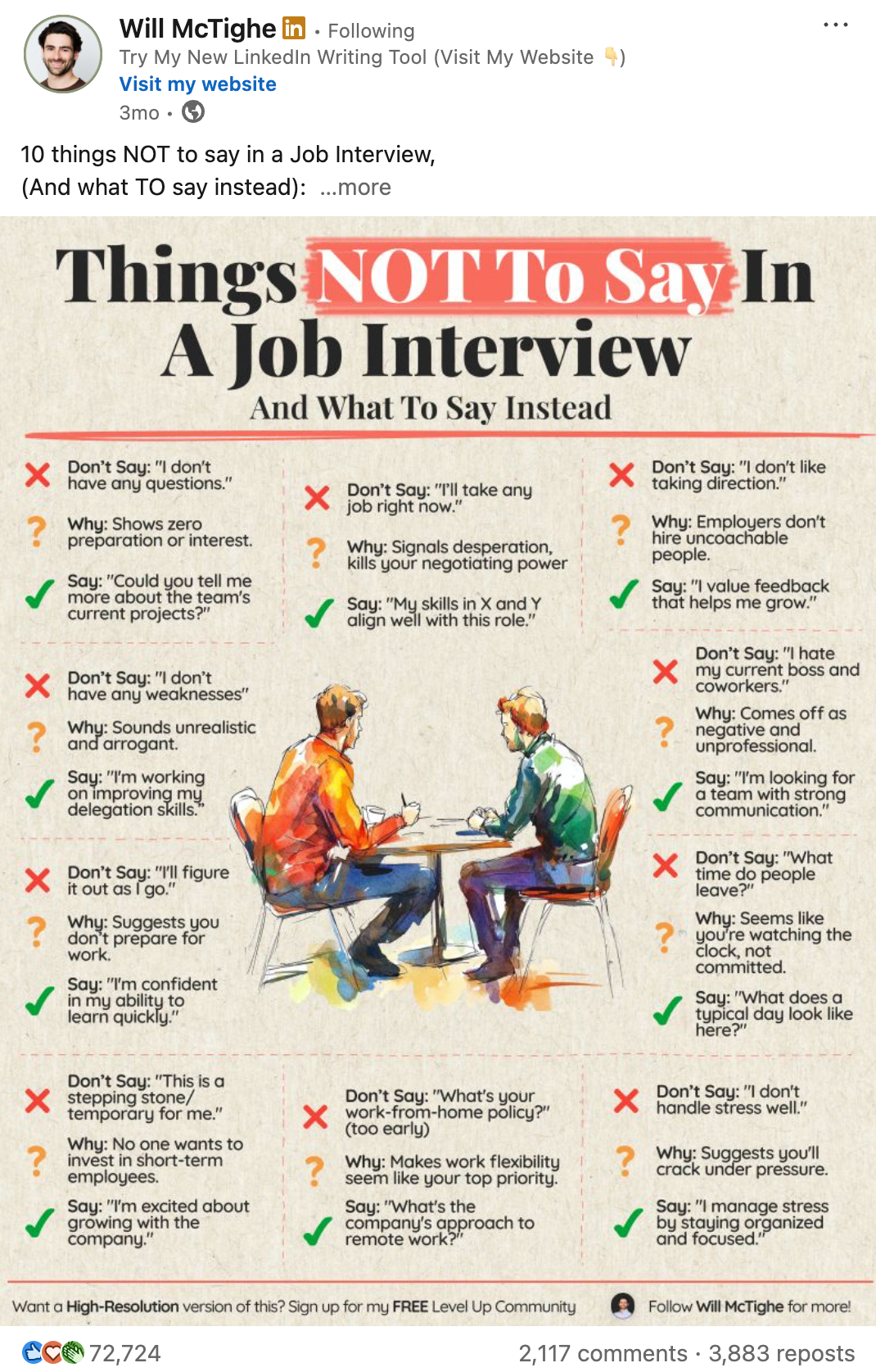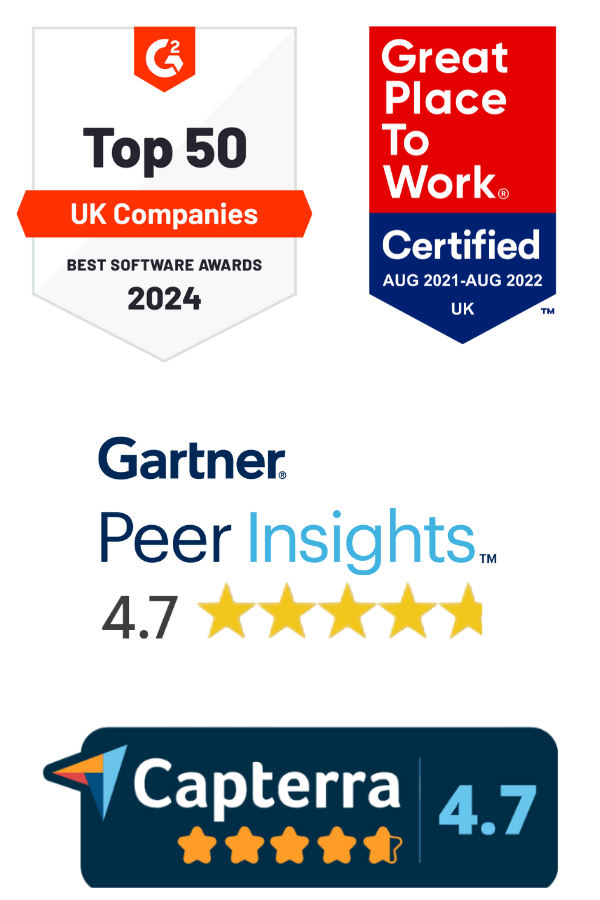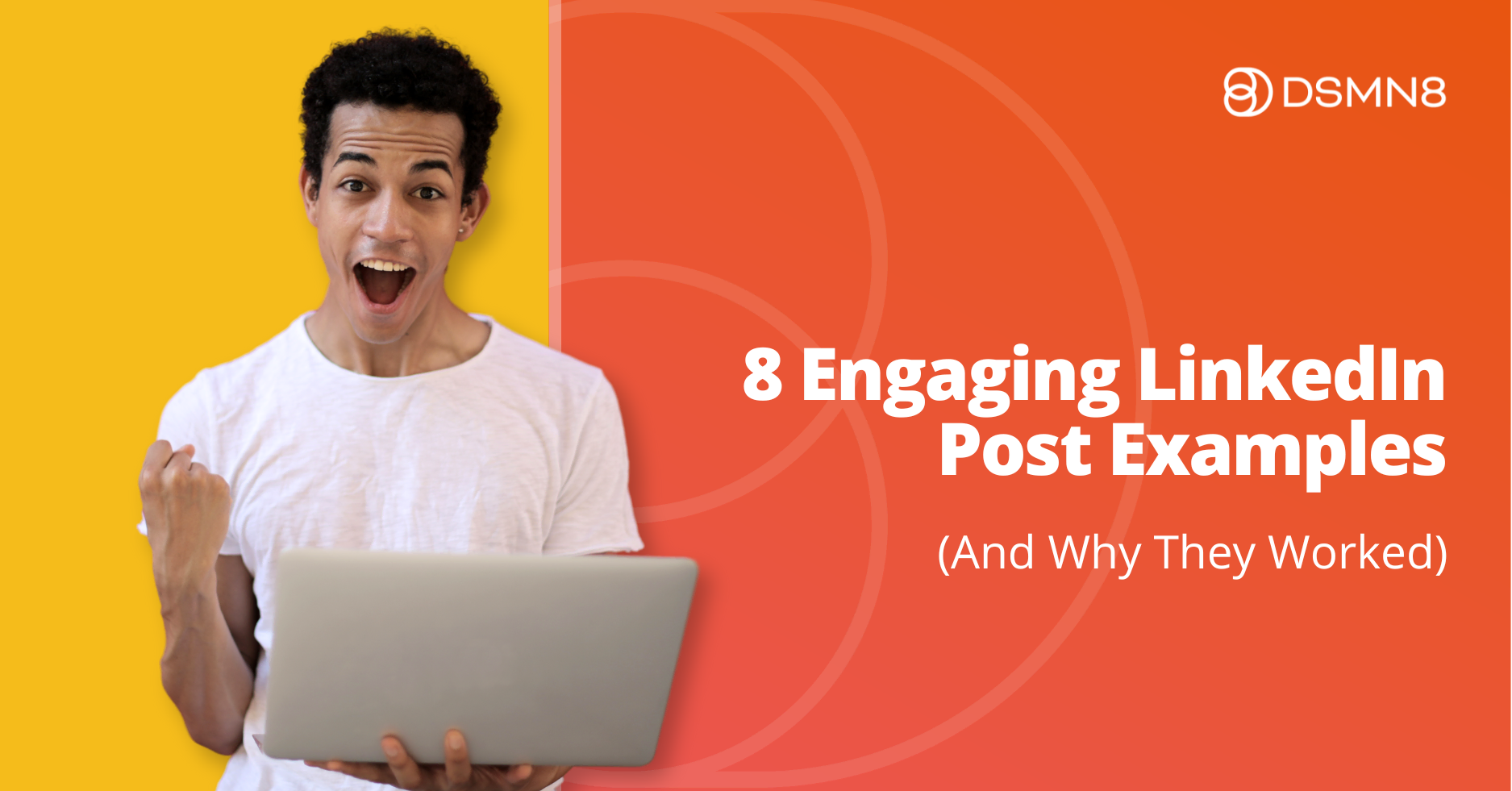
What's on this page:
- 1: Make It Educational AND Actionable.
- 2: Add Your Own Unique Take on a Trending Topic.
- 3: Blunt Posts Ignite LinkedIn Discussions.
- 4: Low Production, High Impact.
- 5: Use Humor to Spark Engagement.
- 6: Provide Helpful Resources like ‘Cheat Sheets’.
- 7: Don’t Try Too Hard to Sound Smart.
- 8: Honest Appreciation Posts Resonate.
- Key Takeaways.
- Additional Resources.
Struggling to figure out what actually works on LinkedIn? You’re not alone. With millions of posts going live daily, it can feel like a mystery why some take off while others fall flat.
To help demystify it, I’ve spoken with eight thought leaders to analyze their top-performing LinkedIn posts and unpack exactly why they performed so well.
Whether it’s bold opinions, sharing valuable resources, or simply being authentic, these examples reveal proven tactics you can apply to boost your own content.
Let’s jump in 👇
1. Make It Educational AND Actionable
In the last year, I’ve had 257 million impressions on LinkedIn.
This post got 20.6m impressions.
Why did it perform well?
The best-performing content on LinkedIn typically has the following properties:
- It is educational and actionable.
- It helps people solve a core problem that brings them to LinkedIn in the first place – changing job.
- It includes a saveable and shareable visual.
- It asks a conversation-starting question at the end.
- It uses formatting that makes it scannable (clear sections, lots of line spacing, occasional emojis for signposting).
The mistake a lot of people make is that they share things that they think are “interesting” but don’t actually solve problems for people.
For this specific post, the “Things NOT to say in a job interview” format works because:
- It addresses a universal anxiety (job interviews).
- It includes both what NOT to do AND constructive alternatives.
- The title on the visual is big and clear.
- The rest of the visual is easy to digest.
- The content is immediately useful to anyone with an interview coming up.
Background:
I was one of the fastest-growing creators on LinkedIn in the world in the last year; I grew from 4k followers in March 2024 to 360k followers in April 2024.
I also run Saywhat, a software product that helps people create more effective LinkedIn content.

Will McTighe, Co-Founder, Saywhat
2. Add Your Own Unique Take on a Trending Topic

So I made this carousel post right when everyone was losing their minds over ChatGPT. The hook was dead simple: “49 AI Tools That Aren’t ChatGPT“, categorised based on your job. This was early 2023 when ChatGPT was basically the only AI tool most people had heard of, but I’d been testing dozens of specialized AI tools that were actually more useful for specific tasks.
The post went stupidly viral. Like 2M+ impressions, thousands of shares, and over 500 comments. What was wild is that people kept discovering it months later through LinkedIn’s algorithm. Even now, two years later, I still get notifications from people commenting on it or sharing it. I’d link it, but honestly, some of the tools I recommended don’t even exist anymore – that’s how fast this space moves.
Why it worked when so many posts don’t – the timing was perfect. Everyone was ChatGPT-obsessed but also feeling its limitations. I hit that sweet spot of “here’s what you’re missing” at exactly the right moment when people were hungry for more than just the big-name tool.
But the real secret is that I spent 7 hours creating that “simple” carousel. Each slide had:
- Actual screenshot of the tool interface (not stock photos).
- Super specific use case (not “this is good for content”).
- Price.
- My personal 2-sentence review based on actually using it.
That’s it. No growth hacks, no tagging 50 influencers bullsh*t at the end. Just genuinely useful content that solved a real problem people had at that exact moment.
The best-performing content is almost always when you’re slightly ahead of the curve on something everyone is about to care about.

Tim Hanson, Chief Marketing Officer, Penfriend
3. Blunt Posts Ignite LinkedIn Discussions
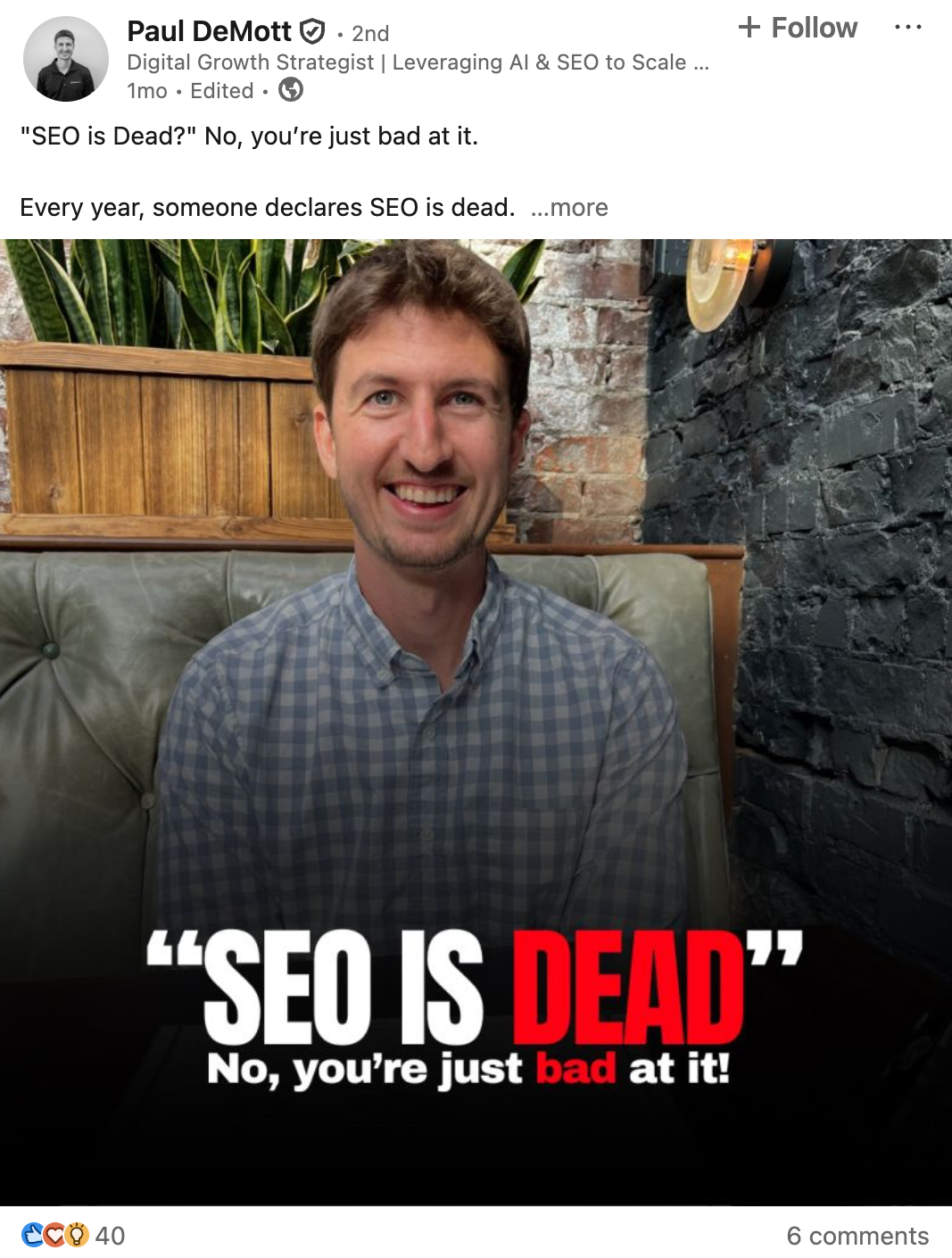
One of the most successful LinkedIn posts I’ve shared was the one where I wrote, “SEO is dead. No, you’re just bad at it.” That line alone sparked a flood of reactions: likes, comments, DMs, everything. It ended up reaching way beyond my typical audience and pulled in SEOs, marketers, and business owners who all had something to say about it.
What made it work was how blunt and direct it was. I wasn’t trying to sugarcoat anything, and I think people are a bit tired of fluff online. The post pushed a button and that’s what made people stop scrolling. But it wasn’t just clickbait. I backed it up with actual context. I talked about how SEO is very much alive, but if you’re doing things the way you did ten years ago, you’re going to get left behind. That sparked real discussion, especially from folks who realized their strategies hadn’t evolved.
The funny thing is, I wrote that post after a call with a client who told me they “gave up on SEO because it just doesn’t work anymore.” Meanwhile, their site was barely crawlable, the content was thin, and their backlinks were all junk. That conversation stuck with me and I knew others were thinking the same thing. So I just called it out publicly.
What really drove engagement was the mix of a strong opinion and real-world experience. People could tell I wasn’t just trying to be edgy. I’ve been in this space long enough to speak from actual results. And once a post triggers emotion, whether it’s agreement, disagreement, or curiosity, it snowballs. That one post opened up a lot of conversations and I think it reminded people that effective SEO is still very much alive if you know what you’re doing

Paul DeMott, Chief Technology Officer, Helium SEO
4. Low Production, High Impact
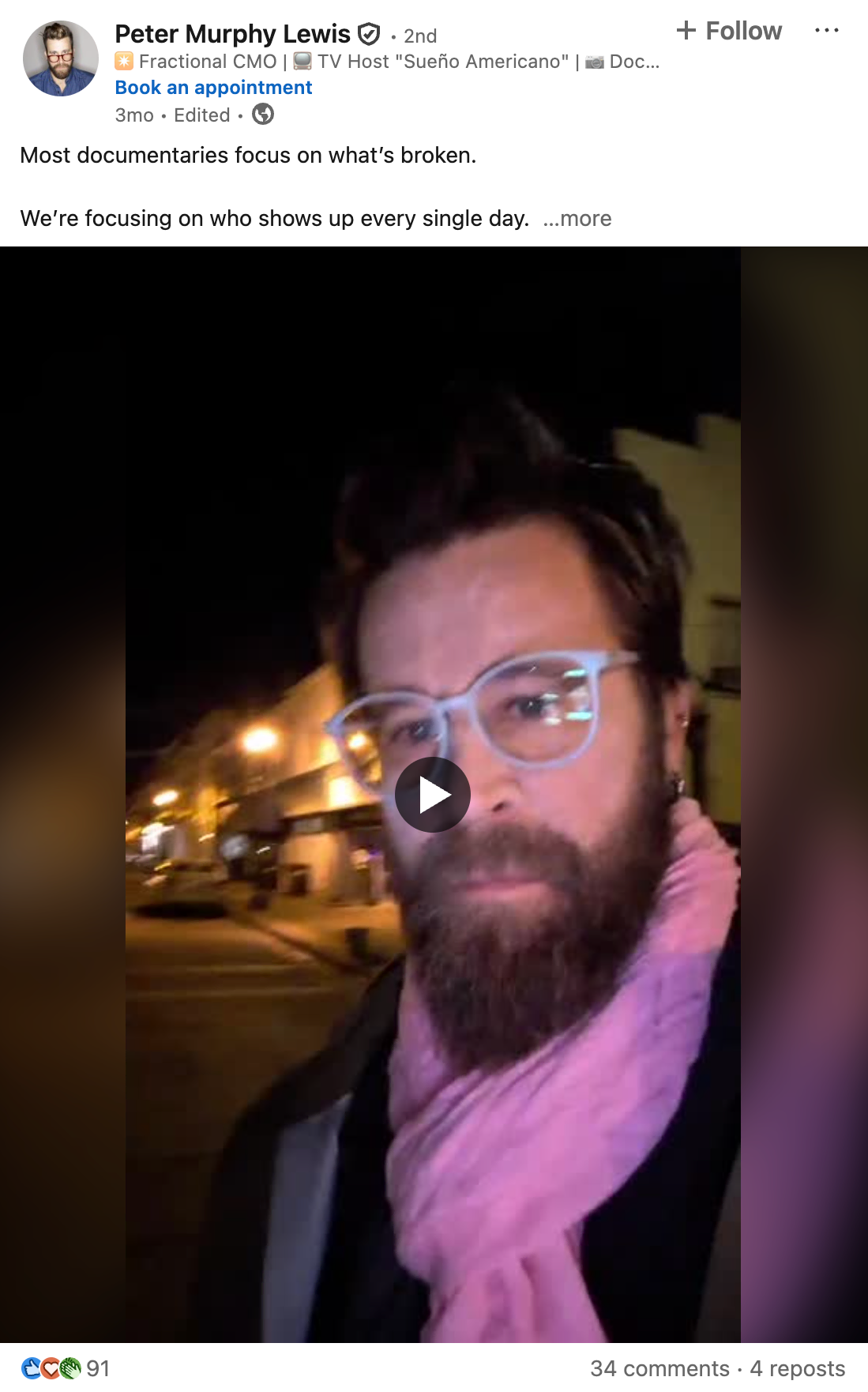
You don’t need high production value to create high-impact content.
One of my most successful LinkedIn posts was filmed on my phone, on the ground in Ripley, Ohio, the day we started shooting Season 2 of People Worth Caring About. The lighting was bad. The wind was loud. But the story was tight.
That post ended up pulling in over 90 likes, 34 comments, and 4 reposts.
It was a message about flipping the narrative. Mainstream media loves chaos. But I wanted to tell the story of the people who quietly keep everything from falling apart: caregivers. The ones who know every name, who do the thankless work, who never make the news unless something goes wrong.
And the reason it worked? I didn’t promote the documentary. I promoted the why. I said the loud part out loud: “If you don’t tell your own story, someone else will – and they’ll probably get it wrong.” It wasn’t a pitch. It was a reminder. And judging by the comments, a lot of people needed one.

Peter Lewis, Chief Marketing Officer, Strategic Pete
5. Use Humor to Spark Engagement
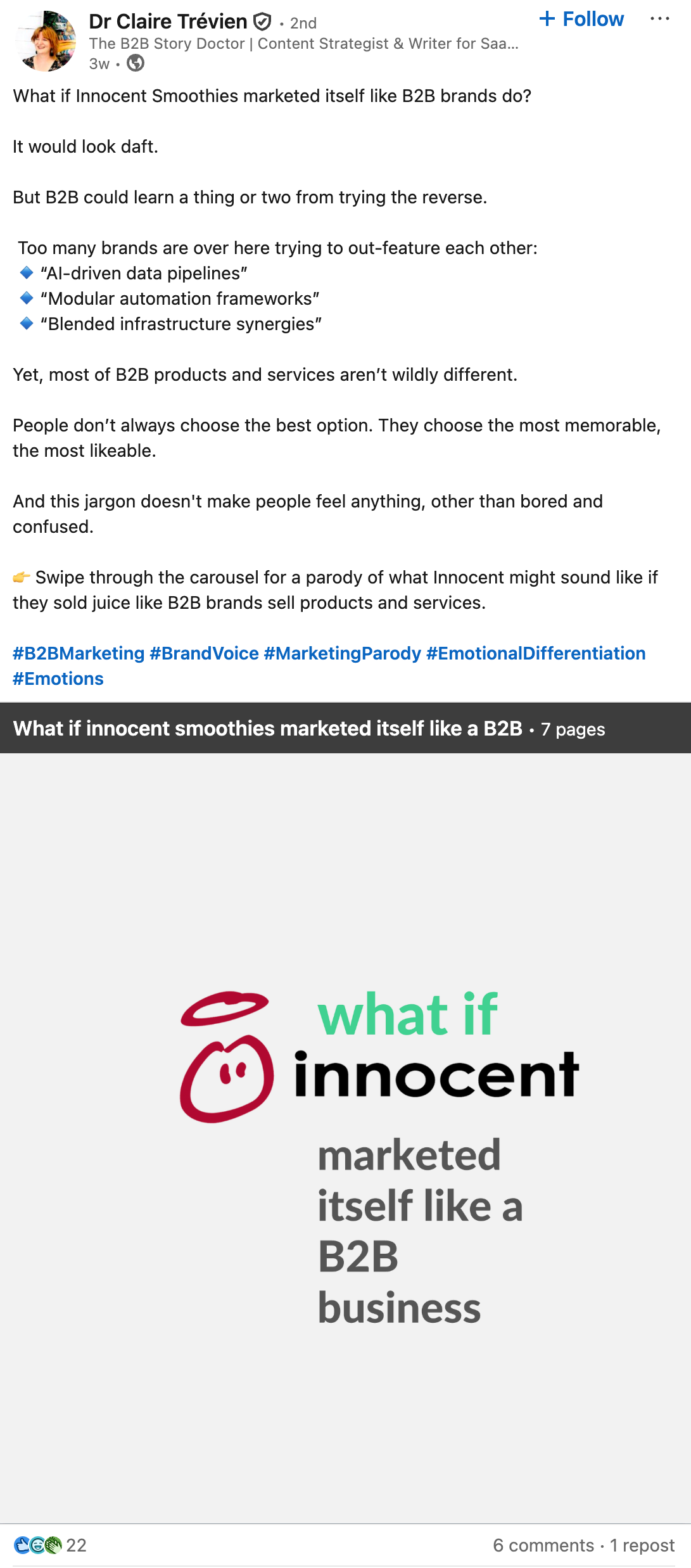
I recently shared a carousel asking the question “What if Innocent branded itself like B2B brands do?” It led to some great reactions and conversations for a couple of reasons:
1) Relatability: Many B2B marketers have seen (or written!) similarly jargon-heavy content.
2) Humour: The light-hearted tone made it easy to engage with.
3) Visual contrast: By contrasting two extremes in tone, it highlighted a broader truth about branding and audience connection.
4) Timing: It was posted mid-week when engagement tends to be higher.

Claire Trevien, Account Director, Isoline Communications
💡 Top tip: use a variety of content formats to engage your audience. The DSMN8 platform allows you to curate a variety of formats for employees, from videos to galleries to carousels for LinkedIn.
6. Provide Helpful Resources like 'Cheat Sheets'
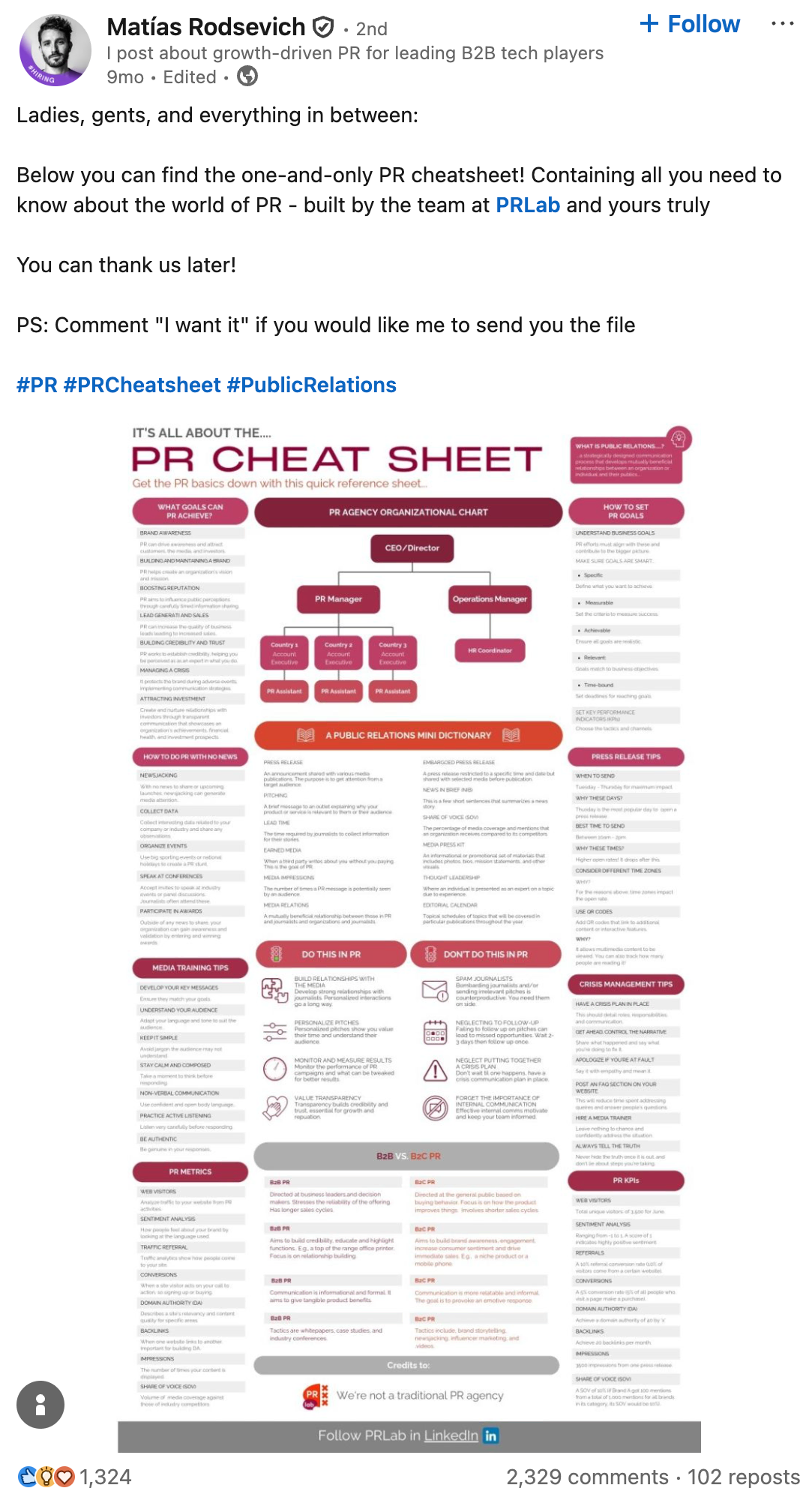
From my perspective, utility drives engagement.
In my case, I shared a PR cheat sheet designed my our agency, PRLab, which consolidated essential public relations concepts into a single, easy-to-digest infographic. The post resonated because it provided immediate value – something professionals could reference daily.
We also studied carefully viral cheat sheets from other industries, like finance, and adapted their design principles to our content.
The result was over 2,300 comments and widespread sharing.

Matias Rodsevich, Founder & CEO, PRLab
7. Don’t Try Too Hard to Sound Smart

One of my best-performing LinkedIn posts was this:
“men woke up one day
realised being an assistant is too feminine
renamed it to founder’s office
and got away with it”
It got 5,000+ likes, 500k impressions and a storm of comments. Some laughed, some got defensive, a few messaged me to say it made them rethink how they present their roles.
What worked?
Not the format. Not the hashtags. Not the algorithm voodoo.
Just one thing: saying something true that no one else was saying out loud.
There’s a sweet spot in content that lives between “offensive” and “obvious.”
That post hit it.
It was:
- Specific (people knew exactly who I was talking about)
- Short (3 lines, no fluff)
- Observational (not preachy, not advice-y)
- And a little cheeky
The weird part? I almost didn’t post it.
Because it felt too simple. Too random.
And I think that’s where a lot of good content dies – in overthinking.
I’ve posted 100s of times on LinkedIn.
Here’s what I’ve learned:
The more you try to sound smart, the fewer people relate.
The posts you’re unsure about often do best.
If it sounds like everyone else, it won’t go anywhere.
Humor > Hustle.
So no, you don’t need to share frameworks or hacks every time.
Sometimes, just calling out the quiet truth is enough.
That’s what makes people stop scrolling.
And sometimes, that’s all content needs to do.

Kunwar Raj, Founder, SuperPen
8. Honest Appreciation Posts Resonate
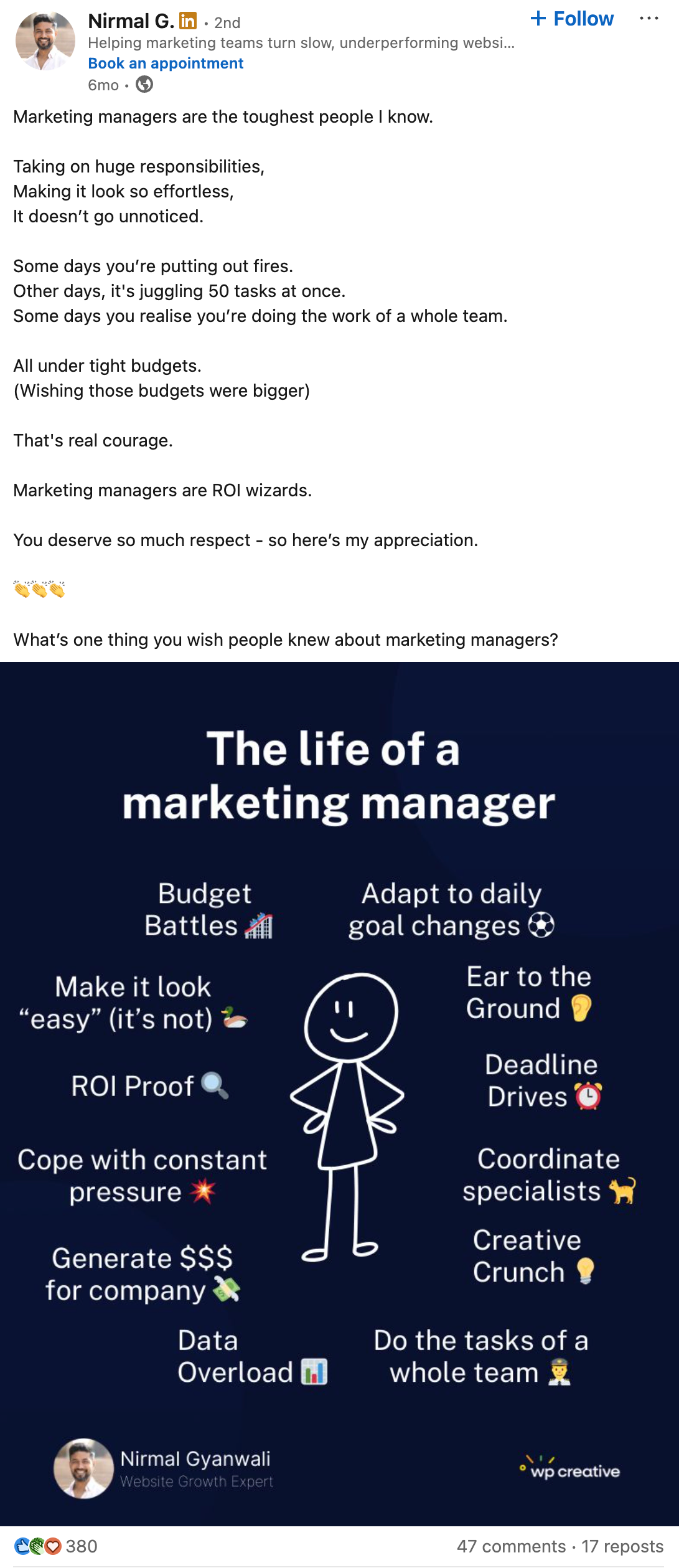
One of my most engaged posts on LinkedIn was just me saying thank you to marketing managers.
It wasn’t planned. I was just thinking about how much marketing managers do and how little credit they get. So I wrote a quick post to say it. That’s it. No CTA. No strategy. Just honesty.
We work with marketing managers all the time, and I’ve seen the pressure they’re under. They’re running campaigns, handling five things at once, managing tiny budgets, and still expected to show results.
The post picked up over 380 reactions, 47 comments, and 17 reposts. I think it worked because it was real. People saw themselves in it, and it started a conversation.
Sometimes the best content isn’t about tips or hacks. It’s just saying what people live through every day.

Nirmal Gyanwali, Founder & CMO, WP Creative
Key Takeaways
What do the most engaging LinkedIn posts have in common? Across all the examples, a few clear themes stood out.
The best posts are actionable, timely, and authentic. Content that solves a specific problem, especially when paired with useful visuals, tends to attract the strongest engagement. Bold opinions also perform well when backed by real experience and insight.
Most importantly, authenticity always wins. Honest, unpolished posts often resonate more than polished corporate messaging.
Whether you are sharing expert advice, personal stories, or simple words of appreciation, the key is to offer real value and keep it human.
Ready to get your team active on LinkedIn?
Book a demo of DSMN8, the #1 user-rated employee advocacy platform.
More on building your LinkedIn presence:
Emily Neal
SEO and Content Specialist at DSMN8. Emily has 10 years experience blogging, and is a pro at Pinterest Marketing, reaching 1 million monthly views. She’s all about empowering employees to grow their personal brands and become influencers.

